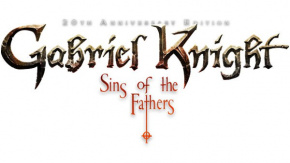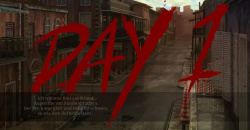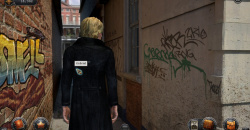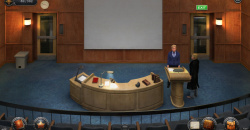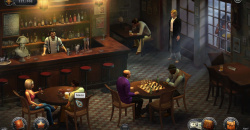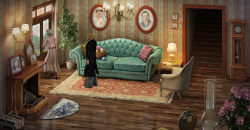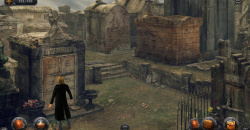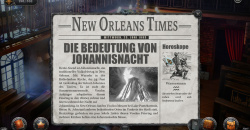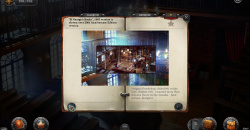Gabriel Knight: Sins of the Fathers 20th Anniversary Edition is the new HD version of the classic 1993 point-and-click adventure game of the same name. Now, 20 years later, Jane Jensen and the developers at Phoenix Online are working to bring out a new and updated edition for iPad, PC, and Mac. A few months ago, we were able to get a look at the first two “days” of the remake, and gave you our impression of the new edition. Now that the full game is out, check out the end of the review to see the final verdict.
Welcome back, Gabriel Knight
Gabriel Knight is a supernatural investigator who has his first adventure in Sins of the Fathers. His life as a novelist and owner of a rare books shop in his hometown of New Orleans doesn’t too out of the ordinary when the series begins. Eventually, however, he discovers that he is a descendant of the Schattenjäger, literally “shadow hunters”, a mysterious line of Bavarian witch hunters who once made their living combating the powers of darkness in the Old World.
In Sins of the Fathers, Gabriel is researching his latest novel, which is supposed to be based on a recent series of “Voodoo Murders” that are currently under investigation. Since the murders have taken place in New Orleans, appropriately enough, Gabriel is able to follow the investigation closely and visit many of the locations and interview some of the people involved. He hopes to use all of this as the inspiration for his new novel. As he digs deeper into the case, he’s able to rely on the help of his assistant Grace Nakimura and detective Franklin Mosely, his ally in the New Orleans Police Department.
Where fun meets frustration
Gabriel Knight: Sins of the Fathers is a typical point-and-click adventure game where you examine, collect, and combine objects and solve puzzles. Clicking on an object opens a menu where you can select from a series of actions like “Look” and “Pick up”. When you pick up an object, it automatically finds its way into your inventory and into a special section next to the inventory icon. What’s kind of confusing is that only one item can go in this spot at once, and if you click on a character they’ll only talk about this particular item. If you want to talk about a different item, you have to select it from the full inventory and put it in this special section. This extra step is really annoying, though, and it would have been better if you could just choose any item directly from your inventory to talk about. Of course, conversations with NPCs are important, and you can’t avoid them if you want to make any progress in the game. One positive thing is that topics of conversation relevant to the plot are highlighted, leaving it up to the player to decide if he or she wants to just play through the story or spend more time collecting other background information about characters, locations, etc.
Of course, in addition to interacting with items and NPCs, you’re going to have to solve a fair number of puzzles, some of which will require you to think way outside the box. One particular puzzle in Jackson Square was particularly nerve-wracking. The idea is to guide a mime to a police officer, but you can’t get too close to any other NPCs on the way, otherwise the mime will go off and start following them and you’ll have to start all over again. Unfortunately, there’s not a whole lot of room to maneuver, and the controls are somewhat imprecise and laggy, which means it took what felt like 20 tries to get it right. This one is definitely going to have some players beating their heads against the table. Fortunately, in the two in-game days we played, this was the only situation where the game got really frustrating. Otherwise, the puzzles are really impressive and are also a whole lot of fun.
It also helps that whenever you solve a puzzle or find an important item, there’s a musical tone that lets you know that the story can move forward and you don’t have to keep clicking on other, useless objects.
Help, I’m stuck!
If you do reach a point where you can’t go any further, however, there’s a multi-tiered help system that gives you little clues about the day’s proceedings. But before that you can also have a look at your journal, which contains all the important discoveries you’ve made so far, arranged neatly enough for you to go back and figure out what you might be missing. It might also help you find your way in the course of some of your investigations, too.
Another helpful feature is the “hotspot” display, which shows you all the objects you can interact with in a given area. Of course, there’s no distinction here between useful and useless objects, so in a worst-case scenario you’re just going to have to click through all of them and figure it out for yourself.
An eerie adventure awaits
The graphics in the 20th Anniversary Edition have been updated, but there are still a few issues that need to be dealt with, and hopefully they’ll have all been taken care of by the time the final version is released (see below for update). For example, sometimes when you want Gabriel to approach objects or NPCs, he just ends up running right through them instead. It’s also confusing how when you click through certain conversations, background animations and NPCs sometimes go through sudden drastic changes – characters can jump from one side of the screen to another, and background animations can look like they’re playing in fast-motion.
Nevertheless, what is immediately apparent is that the new graphics have a lot of potential. The backgrounds in particular look really good, and help to create an eerie atmosphere in the game. In-game animations also help to give the game a more realistic feel, and really go well with the overall package. For example, in Gabriel’s book shop, there’s a shaft of light where you can actually see dust particles floating around.
The numerous locations you can visit throughout the course of the game are designed in a way that gives a lot of attention to detail. Some of the more impressive locations around New Orleans include the St. Louis Cathedral, Jackson Square, a voodoo shop, and a museum. If all the locations in the game are as beautifully designed as the ones you can access in the game’s first two “days”, it’s going to be a lot of fun to visit them all (again, see below for update).
Shut that refrigerator! I can smell it from here!
The spoken dialogue in the game is available only in English at the moment, and subtitles in various other languages appear to be unfinished (see below). However, the voice actors have done an excellent job of breathing life into their respective characters.
There was one female voice in particular who would comment on various actions – for example, when examining an object or when trying to combine items that didn’t seem like they’d go together. This can get pretty annoying after a while, but luckily you can turn it off if you want to.
Another positive feature of the game is that the dialogue is pretty funny. For example, when Gabriel tries to climb a ladder, Grace tells him he’d better climb down if he’s just going to be using the ladder to look down her shirt. Another scene has Gabriel trying to open a refrigerator only to have Grace shout from off-screen to close it because she can smell it from the next room. I’m sure little jokes like these can get annoying after a while, but they’re certainly a lot more innovative than plain texts repeating over and over again that you shouldn’t or can’t do something.
Fan appeal
The game can really be interesting to fans of the original version, especially since after 20 years they’re unlikely to remember how to solve the individual puzzles. In any event, the puzzles have been designed a bit differently in the new edition, or take place on different days than they did in the original.
If that’s not enough, there’s also a lot of special edition content available in the in-game journal or in the game’s interface itself. These include comparisons of scenes from the original game and from the new edition, where you can really see the differences. The preview edition didn’t contain all the bonus material, but there’s also supposed to be audio interviews and other special content along with the images (see below).
Update on full version
The preview version allowed us to play the first two days of the story, but now we’d had the chance to get a closer look at the full version of the game. Not many things have changed compared to the preview version, which is in some ways a good thing and in some ways a bad thing. We’d like to take this opportunity to address whether anything’s been done about the things we criticized in the preview version.
A major point of frustration was the cumbersome controls, and the fact that you had to put an item in a special slot before you could interact with it. Then if you wanted to use a different item, you had to start the whole thing over. Unfortunately, nothing has changed here in the full version, and this circuitous process gets even more annoying after a few hours of playing.
They didn’t really change anything about the graphics, either. Gabriel still just walks right through NPCs and objects instead of walking around them, characters still jump back and forth when you clock through dialogues and descriptions, and certain animations still look like they’re playing in fast motion. One positive thing, though is that the areas and locations you can visit in the rest of the game are just as beautiful and full of detail as in the preview. The animations in these places provide that little bit extra, and bring the locations to life.
The full version includes complete texts in other languages besides English, though these are sometimes plagued with misspellings and grammatical errors. And in itself that’s probably one of those things that wouldn’t be all that important unless you’re the kind of person who really cares about such things. But when you don’t understand a hint because it’s poorly translated, then it can get a bit distressing. Voiceovers are all still in English.
The developers also promised to add more bonus content in addition to the images comparing the original game with the new edition, and they’ve followed through. There are audio interviews with several people involved in the game, including Jane Jensen herself. Also included is some concept art from early stages in the game’s development.





